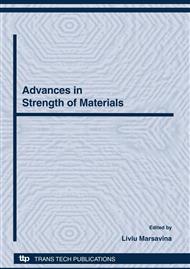[1]
Apotheker H, Nishimura I, Seerattan C. Laser welded vs soldered non precious alloy dental bridges: A comparative study. Lasers in surgery and medicine 1984; 4: 207-213.
DOI: 10.1002/lsm.1900040213
Google Scholar
[2]
Bertrand C. La soudure au laser : une technique d'avenir au laboratoire de prothèse. Arts et Technique Dentaires, 1995; 6: 363-368.
Google Scholar
[3]
Bortun, C., N. Faur, A. Cernescu, S. Porojan, O. Gomboş, L. Sandu, B. Ghiban: Finite Element Analysis For Stress Distribution In Welded Zones Used In RPD Technology, 14th Swiss Conference on Biomaterials, Basel, 8 mai (2008).
Google Scholar
[4]
Borţun Cristina, Mitelea I., Miloş L., Bîrdeanu V., Sandu Liliana: Analysis of laser welded joints on C alloy used in removable partial dentures technology, European Cells and Materials, vol. 10 Suppl 1, 2005, pg. 31. ISSN 1473-2262.
Google Scholar
[5]
Borţun Cristina., S. Porojan, L. Sandu, M. Iacob, B. Ghiban: Thermic Treatments For Some Welded CoCrMo Alloys Used In Removable Partial Dentures Tehnology Program and Abstracts Swiss Society for Biomaterials, 13th General Meeting, 9 may 2007, Neuchatel, Elveţia Europeean Cells and Materials vol 13. Suppl. 3. 2007 (pg. 32), ISSN 1473-2262.
Google Scholar
[6]
Brooks J A. Effect of alloy modifications on HAZ Cracking of A286 stainless Steel. Welding Journal 1974; November: 517s-523s.
Google Scholar
[7]
Cieslak M J, Stephens J J, Carr J J. A study of weldability and weld related microstructure of Cabot alloy 214. Metallurgical Transactions A 1988 19A: 657-67.
DOI: 10.1007/bf02649280
Google Scholar
[8]
Dobberstein H, Orlick H, Fisher P, Zhurt R. Experimental studies of the laser welding of Cr-Co alloys using a pulse laser 6d-Yag. Zahn, Mund, Und Kieferheilkunde Mit Zentralblatt 1989; 77: 578-579.
Google Scholar
[9]
Dobberstein H. Orlick H. Zuhrt R. The welding of cobalt-chromium, nickel-chromium and silver-palladium alloys using a solid state laser. - Zahn Mund, Und Kieferheilkunde Mit Zentralblatt 1990; 78: 259-61.
Google Scholar
[10]
Faur N: Elemente finite - fundamente, Ed. Politehnica, Timişoara, (2002).
Google Scholar
[11]
Frolov V A et al. Light beam welding thin sheets of titanium alloy. - Welding International 1994; 8: 41-42.
DOI: 10.1080/09507119409548541
Google Scholar
[12]
Hoffman J. Dental laser welding technique. Procedural report. 1. Quality, expense, and risks of innovative bonding technique. Dental labor 1992; 40 : 1221-4.
Google Scholar
[13]
Hoffmann J. Dental laser welding technique. Procedural report 2. Indications for use of innovative technique. Dental Labor 40: 1321-28.
Google Scholar
[14]
Kou Sindo: Welding Metallurgy, Second edition, Ed. Wiley Interscience, a John Wiley &Sons, Inc. Publication, (2002).
Google Scholar
[15]
Lindgren Laers-Erik: Computational welding mechanics, Thermomechanical and microstructural simulations, Woodhead Publishing Limited, (2007).
Google Scholar
[16]
Matsuda S, Veyama T. Solidification crack susceptibility of laser weld metal in 0. 2C-6i-Cr-Co steels: effects of bead configuration and S and P contents. Welding International 1993; 7: 686-92.
DOI: 10.1080/09507119309548473
Google Scholar
[17]
Ninh, N.T., M.A. Wahab, The effect of residual stresses and weld geometry on the improvement of fatigue life, J. Mater. Process. Technol. 48 (1995) 581-588.
DOI: 10.1016/0924-0136(94)01697-y
Google Scholar
[18]
Sandu Liliana, Cristina Borţun: Three Dimensional Finite Element Analysis of Thermal Stresses in the Cast Clasps, 12th International Dental Congress of the Egyptian Dental Clinical Society, march 22-24, 2006, Cairo, pg. 54.
Google Scholar
[19]
Sandu Liliana, V. Bîrdeanu, Cristina Borţun, F. Topală: Laser welding procedures applied to removable partial dentures frameworks repairs, European Cells and Materials, Vol. 11, Suppl. 2, 2006, pg. 29. ISSN 1473-2262.
Google Scholar
[20]
Sjogren G, Anderson M, Bergman M. Laser welding of titanium in dentistry. Acta Odontol Scand 1988; 46: 247-253.
Google Scholar
[21]
Van Benthem H. Advantages of laser welding compared to conventional joining. Quintessenz Der Zahntechnick 17: 1178-1193.
Google Scholar
[22]
Yajiang Li *, Wang Juan, Chen Maoai, Shen Xiaoqin: Finite element analysis of residual stress in the welded zone of a high strength steel. Bull. Mater. Sci., Vol. 27, No. 2, April 2004, pp.127-132. © Indian Academy of Sciences.
DOI: 10.1007/bf02708494
Google Scholar
[23]
Yang, Y.S., K. -J. Son, S. -K. Cho, S. -G. Hong, S. -K. Kim, K. -H. Mo, Effect of residual stress on fatigue strength of resistance spot weldment, Sci. Technol. Weld. Joi. 6 (2001) 397-401.
DOI: 10.1179/stw.2001.6.6.397
Google Scholar


